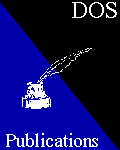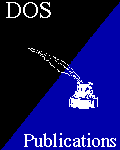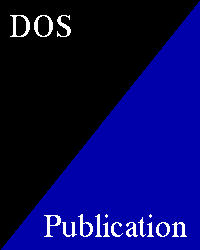
DOS
Betamax's
DOS PUBLICATIONS
BUSINESS


|
|
Doctor DOS Betamax's |
DOS PUBLICATIONS
|
The following presents DOS books with an orientation toward
business. They include accounting, databases, spreadsheeting
and word processing, among other topics. Realise that books
in other categories may contain these topics as well.
INFORMATION AND IMAGES BELOW MAY NOT BE
REPRODUCED WITHOUT PERMISSION FROM THE AUTHOR ©

 |
Business Programming in A for DOS-Based Systems 1993 by A.C. Millspuagh ISBN: 0-15-500139-6 This programers' reference covers C++ and QuickC. It streses screen design (both text and graphic) and report layout, discusses menu programs, string handling, programming structure and logic, data structures, linked lists and object-oriented programming. In addition are chapters on functions and variables, and on arrays. Appendix topics include ANSI, library functions, operators, and using the editors. The latter discusses entering a program and then compiling and running your program, among other related subjects. A glossary rounds out this useful book. |


|
Complete Guide to Corel WordPerfect 6.x for DOS 1996 by Madelyn Lenard and Greg Johnson ISBN: 0-31420-464-4 This covers the DOS graphic version of WordPerfect. It details all aspects of this popular word processor and covers the new features added for this version. (No further details.) |
|
Computerized Accounting with ACCPAC Plus 1995 by Peter Fuhrman and Andre Choquette ISBN: 0-13-190083-8 ACCPAC Plus is one of the most popular accounting software packages ever, and its DOS versions are still revered today. This book, which covers up to version 6.1, includes instructions for all modules such as Accounts Receivable and Payable, Order Entry, General Ledger, etc. Month-End and Year-End procedures are detailed along with maintenance and backup methods. A bonus for Canadians is the section on "Canadian Payroll". Despite its lack of an index, this is still a must-have tutorial. Recommended. |
 |

 |
DOS, WordPerfect & Lotus Office Companion 1993 by Robert Harris ISBN: 1-56604-048-5 (Third Edition) This was the book that taught me DOS when I wanted to learn more than just turning on the computer and starting programs from pre-made menus or from various shell programs. (I have since shunned all shells and DOS menus in favour of the much more direct and efficient command-line.) This publication educated me with information about the DOS office systems I used every day, increasing my performance level with those systems. The Office Companion covers up to DOS 6, WordPerfect 6 and 1-2-3 Version 2.4. It is recommended for beginners, but has many useful tips for any level of proficiency. All the basics are covered and common errors discussed. A nice, quick reference with keyboard shortcuts is given for each, divided by program and by task desired. |

 |
Generic CADD 5.0 Inside & Out 1991 by Ray Freeman III ISBN: 0-07-881712-9 A thorough tutorial for using this computer aided design program. Described are the CAD drawing medium, its installation and implementation, then the basics through the rendering of advanced concepts are shown. A chapter is devoted to printers, plotters, pointing devices and tablets. Finally, the programmable menu system is demonstrated. Appendices cover commands and related software that can be used with Generic CADD. |
|
Getting Started with WordPerfect 5.1 1991 by Jerry Murphy ISBN: 0-471-54429-9 A beginner book for those new to WordPerfect, it is laid out as a series of brief lessons on topics such as getting started, text blocking, searching, macros, graphics, tables & spreadsheets, and so on. An included disc contains course lessons. |
 |
 |
Google Hacks 100 Industrial-Strength Tips & Tools 2003 by Tara Calishane and Rael Dornfest ISBN: 0-596-00447-8 A book not about DOS at all, but useful for any user (DOS or not) doing Internet searches. It is invaluable for any person or business that wishes to include Google services on his or her website. (This site combines two of those services for one of its internal search services.) Because the information is so valuable and because the advanced methods incorporate the Perl script language which is available for DOS, it was decided to provide this title here. Note that for non-programmers, there are still many methods that don't use scripting, plus a plethora of tips useful for any Internet search. Beginning with search basics and advancing to more involved methods, the authors describe techniques that allow one to focus searches so as to narrow the results and find desired information faster. The range of customisation available to both the user and web author is quite extensive. Some tips work with other search engines, but most are Google exclusives. Next are described some of Google's data collections and how to search within them. These include images, UseNet newsgroups and news. Beyond the above, developers are taught how to access Google's database of search results for web applications and games, and are given methods through which webpages can achieve better search engine rankings. In the process, the latter improve a page's design for more than just ranking purposes. The phrase "wealth of knowledge" is a cliche that actually applies to this book. One thing that detracts from it though, is an unusual number of grammar errors. Despite these making for a distracting read at times, it is a highly recommended publication. |

 |
Harvard Graphics Quick Reference 1991 by CAroline Halliday ISBN: 0-88022-538-6 A Que book, this condenses into categories what is required to run Harvard Graphics. Each lists the commands used followed by a short description afterward. A useful book for intermediate Harvard Graphics users that just need a quick brushup or a fast check of commands already learned. |
|
Harvard Graphics 2.3 Made Easy 1990 by Mary Campbell ISBN: 0-07-881692-0 A detailed look at producing graphics for business purposes. Charts and graphs are covered including importing 1-2-3 or Excel spreadsheet data, selecting and placing images, dealing with maps, creating multiple charts, animations, and much more. Manipulation of individual parts of the chart include its overall appearance, adding grid lines, changing the view angle (axes), adding labels, and selecting colour. Also discussed are the built-in gallery options, templates, drawing from scratch, and macros. Extensive printer options are given and discussion of the VDI (Virtual Device Interface) is included. |
 |

 |
Inside Lotus 1-2-3 Macros Revised and Expanded 1989 by Richard Ridington and Scot Tucker ISBN: 0-13-463522-1 For the efficient user, nothing competes with macros. They can automate every procedure large and small, saving enumeral keystrokes or mouse clicks. This book describes how to create, change and use macros, plus advanced techniques. The book ends with a chapter on tips and tools for macro development. |

 |
Learn at First Sight WordPerfect 6.0 for DOS 1993 by Ruth Maran ISBN: 0-13-002197-0 Continuing the maranGraphics series, this book outlines the basic WordPerfect 6 methods in a clear and concise manner. Each function is illustrated with representative graphic images to help the user visualise what is happening. Although it shows all menus required to do a given operation, it wisely promotes the direct keyboard shortcuts that users should incorporate when typing into a word processor. (Since one's hands are already on the keys, it makes no sense to elicit carpal-tunnel syndrome by constantly moving back & forth between the keys and mouse.) It does discuss the usage of the mouse for highlighting text, however. This is a nice little book for a fast, direct tutorial on word processing with an emphasis on typical business office tasks. |
|
Lotus 1-2-3 Instant Reference 1991 by Judd Robbins ISBN: 0-89588-658-8 A handy reference for 1-2-3 users, it discusses the basics of spreadsheet usage, then goes on to each of the worksheet "slash" operations. A third section details all `@' functions, and finally there is a section of macro keyword definitions and command equivalents. The inside covers and adjacent pages have charts of all the common functions and mode indicators. This book is even helpful to those with later 1-2-3 versions because keystrokes and other basics remained backward compatible. |
 |

 |
Mastering AutoCAD 1987 by George Omura ISBN: 0-89588-574-3 This covers up to version 10, including 3D shading aspects. Starting with the basics of computer aided design, the book talks about interfacing with the DOS operating system, and customising hardware and software. After that is a very detailed course on using this complex and capable program plus a concise chapter on using the program's extensive 3D capabilities. Several chapters are devoted to customising the menus, and using shortcuts and various tips. Appendices cover DOS commands, external software and system variables. |
|
Mobile Office Magazine Laptop Sourcebook 1992 by Peter Otte ISBN: 0-553-35164-8 A borderline book for this website because of its age, but there is much information to be had here, most of which is DOS related. Anyone using an older laptop will find this book invaluable, and anyone using DOS on newer laptops will still find useful information here. Topics include ones on extending battery life, telecommunications, LANs, faxing, wireless communications, computing on the road and much, much more. A disc is included. |
 |

 |
NetWare LAN Management Toolkit 1992 by John McCann and Rick Segal ISBN: 0-672-30170-9 A recommended book for anyone wanting to set up a DOS networked system. All the aspects are thoroughly laid out for the beginner and intermediate user including history, cabling, and protocols. The book then discusses in detail the necessary software and add-on tools that make a network run smoothly and trouble-free. A great resource is the included disc which contains an amazing variety of programs. A plus is the inclusion of a multitude of example batch files that automate the running and care of your network. |
|
NetWare Supervisor's Guide 1995 by John McCann ISBN: 1-55851-402-3 Author McCann provides another detailed book on using NetWare, but this time from an admistration perspective. This is for version 4.1 but previous versions are included. Topics covered are the expected NetWare components and installation, but extensive discussions of managing and maintaining a network, and diagnostics and troubleshooting are focused upon. An excellent feature is the detailed appendices that include abbreviations, protocols, console parameters, and much much more. Reconmmended. |
 |
 |
New Deal Office 97 for DOS 1997 by (No Author Credited) ISBN: ? A program book for New Deal Office, a DOS office suite consisting of a word processor, spreadsheet, day planner, paint program, rotodex, database, scrapbook, communications program, text editor, banner maker, a book reader (yes, long before Kindle!), plus a game. Also included is a desktop manager for the suite plus a task switcher. All are described in detail in this complete manual. The Appendix section covers special characters, preferences, math and database functions, character codes, the book reader, and there is a section detailing add-ons, game packages and available font packages. |

 |
1-2-3 Financial Macros 1985 by Thomas Carlton ISBN: 1-88022-168-2 This is an excellent book for those that prefer to create their own spreadsheet shortcuts to avoid mousing through menus for every operation. Although meant for business 1-2-3 users, the principles discussed here can be applied to most spreadhseet programs that have a "Macros" feature, despite the age of this book. Discussed are step-by-step methods to decide when a macro is required and then how to create an appropriate one. |

 |
Perfect Word Perfect 6 Documents 1993 by Marianne Carroll ISBN: 1-56686-052-0 For those using a graphic version of WordPerfect, this is is a good book from which to learn how to produce professional results. Discussed are methods to not only turn out documents, but also letterheads, flyers, invoices, labels and other printed materials. Covered also are customising the button bar, multiple windows, macros, mail merge, tables, and linking with 1-2-3 and Excel spreadsheet files, plus many time-saving techniques. |

 |
Understanding dBASE IV 1989 by Alan Simpson ISBN: 0-89588-509-3 The non-programming aspects of dBASE are shown regarding database design and usage. Creating, sorting and searching databases is covered along with reports and custom forms, controlling data, and managing related files. Setting up a full business processing system for invoicing, statements, accounts, customer list management and inventory control is done in depth. A very detailed book. |
|
Understanding Local Area Networks 1995 by Neil Jenkins and Stan Schatt ISBN: 0-672-30840-1 (Fifth Edition) A detailed look at setting up and maintaining a LAN for the home or office is covered here. The basics are discussed including network layouts and cabling, standards and protocols, and hardware. Various types of networks and softwares are covered, the latter spanning DOS, Macintosh and Windows. Chapters are devoted to Novell NetWare and to the NT and IBM servers. |
 |
 |
Using Lotus 1-2-3 for DOS Release 3.1+ 1993 by PITTER ISBN: 978-0070502970 No Details other than this book contains test questions within its tutorials. |
|
Using Novell NetWare 3 1992 by Bill Lawrence ISBN: 0-88022-756-7 Novell is the most popular network software for DOS. Its workings and setup are detailed here starting with network components and the features and functions of NetWare. It tells how to manage users and share hardware, have the system be secure and how to make your network run efficiently. It even discusses interfacing with Macintosh, OS/2 and Windows workstations. |
 |

 |
WordPerfect 5.1: The Complete Reference 1990 by Karen Acerson ISBN: 0-07-881634-3 Here is a thick, truly complete book for WordPerfect users. It is extremely detailed with many examples to teach newbies, but also to help seasoned users learn more intricate abilities. Topics include installing and customising, printing, tables and graphics, desktop publishing, macros.and much, much more. If you want to know everything about WordPerfect 5.1, this is the book for you. |
|
WordPerfect 5.1 Macros and Templates 1990 by Gordon McComb ISBN: 0-553-34875-2 This is something all WordPerfect users should have regardless of the version being used. Learning to employ macros means that repetitious operations can be reduced to one command or even just one keystroke. This book shows how to create and edit macros with hundreds of examples and templates. Also covered are the macro language, creating keyboard layouts, creating interactive menus and shell macros, adding power and enhancements to macros, and a lot more. Realise that the macros presented here will work in later versions of WordPerfect with few to no modifications, so buy this book if you see a copy. Includes two discs. |
 |
 |
WordPerfect 5.1 Tips, Tricks, and Traps 1990 by Charles Stewart, Joel Shore, Daniel Rosenbaum ISBN: 0-88022-557-2 (Third Edition) An excellent book on what many consider to be the best word processor program version ever. It contains easy, concise instructions on the many aspects of WordPerfect, but the number of lesser known tips are what makes this publication well worth seeking out. The review of start-up command-line options alone is worth the price of the book. Particular chapters to read are those dealing with macros and keyboard definitions which make creating documents a breeze, and the one on inserting images and clipart into your documents to dress them up. Screen capturing and converting external graphics are covered too. Recommended. |
|
WordPerfect 6 for DOS 1993 by Grace Beatty and David Gardner ISBN: 1-55958-310-X A tutorial that foregoes keyboard shortcuts altogether, this is suitable for anyone using any DOS graphic version of WordPerfect. It shows, in a very fast fashion, on what to click to get the desired results for the most common word processing tasks. Each lesson is fully illustrated with the appropriate screen seen by the user and lines pointing directly to each menu item or icon, with a written explanation beside it. It's like having a person there pointing on the screen as he or she teaches you how to work the basics of program. The simplicity of its style makes this a recommended book for those using the menu system of WordPerfect 6. In addition, since each screen shot is accurate, the keyboard shortcuts are visible (although not discussed), so that after one becomes comfortable, one can begin employing these and skip most menu scanning altogether. |
 |
 |
WordPerfect 6 Made Easy 1993 by Mella Mincberg ISBN: 0-07-881895-8 A WordPerfect book for new and intermediate users. It discusses aspects of this version and how it differs from the previous 5.1, plus how to easily change one's methods from using 5.1 to the newer version. Also given are how to use the converter programs that allow usage of WP 5.1 macros, dictionary and other files a user may have available from 5.1. Despite more mouse operations being available, Mella thankfully gives the faster, more direct keyboard shortcuts for every operation along with the menu/mouse method. To make that easy, a keyboard template is provided along with a complete menu-item reference. The book then goes into detail about creating various types of documents, desktop publishing, graphic work, and much more. A recommended book. |
|
WordPerfect Workbook for IBM Personal Computers 1988 by ? ISBN: 1-55692-200-0 This is a textbook for WordPerfect 5.0. Although older, it is so well laid out and informative that it has been included here. All aspects of this program are covered in separate, easy-to-follow lessons. Each step is carefully and fully explained to complete the task being taught. Recommended. |
 |
A special thankyou to Colin Conrad and Babs Walker
of Dartmouth, Nova Scotia for book cover scans work.
Thanks to Richard Bonner of Dartmouth, Nova Scotia
for digital "repairs" to the covers.
Be sure to check
DOS Websites
for links to some of the programs
mentioned in this publications reference.
|
Return to the Books Table of Contents |
Return to the Publications Table of Contents |

|
|